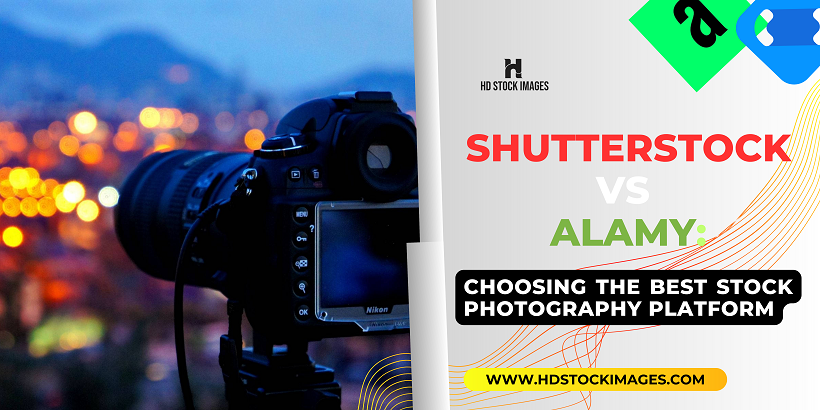1. Introduction
In today's digital age, the use of high-quality images has become an integral part of various industries, from marketing and advertising to web design and publishing. Stock photography platforms play a crucial role in providing a vast collection of images that cater to these diverse needs. Two prominent players in the stock photography market are Shutterstock and Alamy. Both platforms offer an extensive range of images, but choosing the best one for your specific requirements can be a daunting task.
This blog post aims to simplify the decision-making process by comparing Shutterstock and Alamy, highlighting their features, benefits, and drawbacks. Whether you're a marketer searching for captivating visuals or a designer in need of compelling imagery, understanding the differences between these platforms will help you make an informed choice.
Also Read This: Here’s How You Can Download IG Reel Without Watermark
2. Overview of Shutterstock

Shutterstock is a renowned stock photography platform that has established itself as a go-to resource for millions of creatives and businesses worldwide. With a rich history in the industry, Shutterstock offers a wide range of features and benefits that make it a popular choice among users.
One of the key advantages of Shutterstock is its vast library of high-quality images. With millions of images available, covering various themes, subjects, and styles, users have a wide selection to choose from. Whether you need visuals for commercial projects, social media campaigns, or website design, Shutterstock is likely to have the perfect image to meet your needs.
The user-friendly interface and advanced search functionality are additional strengths of Shutterstock. The platform allows users to easily navigate and find the images they are looking for. The search feature includes filters such as color, orientation, and image type, enabling users to narrow down their search and save valuable time.
When it comes to licensing options and pricing, Shutterstock offers flexibility to accommodate different budgets and usage requirements. They provide various licensing options, including standard and extended licenses, to cater to different commercial needs. Moreover, their pricing structure offers subscription plans for regular users and on-demand purchasing options for those with more sporadic image requirements.
Shutterstock also has a contributor program that allows photographers and artists to showcase and sell their work on the platform. This feature benefits both contributors and users, as it ensures a constant stream of fresh and diverse content.
While Shutterstock offers many advantages, it's important to consider some potential drawbacks. The sheer size of its library can sometimes make it overwhelming to find the perfect image, and there is a possibility of encountering images that have been overused or appear in multiple contexts. Additionally, the pricing may not be suitable for those on a tight budget or with specific licensing needs.
Overall, Shutterstock is a popular choice due to its extensive image library, user-friendly interface, and flexible licensing options. It continues to serve as a reliable resource for individuals and businesses seeking high-quality visuals for their creative projects.
Also Read This: Alamy Images Reverse Image Search: Discover Similar or Exact Image
3. Overview of Alamy

Alamy is another prominent player in the stock photography industry, offering a unique approach and features that set it apart from other platforms. With a strong reputation for its diverse collection of images, Alamy caters to a wide range of creative needs.
Alamy boasts an extensive library of images, covering a wide array of subjects and niches. Their collection includes not only traditional stock photos but also illustrations, vectors, and even archival images. This breadth of content ensures that users can find images that align with their specific requirements, regardless of the industry or niche they belong to.
One standout feature of Alamy is its licensing options. In addition to standard licenses, Alamy offers unique licensing models, such as the Rights-Managed and Novel Use licenses. These options allow users to have more control over how the images are used, providing a level of customization and exclusivity for their projects. This flexibility can be particularly beneficial for businesses with specific branding needs or sensitive image usage requirements.
Alamy Image Manager is another notable feature that sets it apart. This tool allows users to organize and manage their downloaded images effectively. With features like keywording, tagging, and collections, users can easily keep track of their image assets and streamline their workflow.
Similar to Shutterstock, Alamy also has a contributor program that encourages photographers and artists to showcase and sell their work on the platform. Contributors can benefit from a fair and transparent royalty structure, ensuring that they are appropriately compensated for their creative contributions.
While Alamy has many strengths, there are a few considerations to keep in mind. The user interface may not be as intuitive as some other platforms, which could impact the ease of finding and selecting images. Additionally, due to its vast collection, there might be some variability in image quality and consistency.
Overall, Alamy stands out for its diverse image collection, unique licensing options, and effective image management tools. It appeals to users who are looking for a platform that offers customization and exclusivity in their image licensing, making it a compelling choice for businesses with specific branding requirements or niche needs.
Also Read This: Here is The Simplest Way to Deactivate Flickr Account
5. Comparison of Shutterstock and Alamy
When choosing the best stock photography platform for your needs, it's crucial to compare and evaluate the features, benefits, and drawbacks of different options. Here, we will compare Shutterstock and Alamy across various aspects to help you make an informed decision.
A. Image quality and selection:
Shutterstock: Boasts a vast library of high-quality images covering a wide range of themes and styles. Images undergo a rigorous review process to maintain quality standards.
Alamy: Offers a diverse collection of images, including traditional stock photos, illustrations, vectors, and archival images. Image quality may vary due to the wide range of contributors.
B. Pricing and licensing options:
Shutterstock: Provides flexible pricing options, including subscription plans and on-demand purchasing. Offers standard and extended licenses to cater to different commercial needs.
Alamy: Offers unique licensing models, including Rights-Managed and Novel Use licenses, in addition to standard licenses. Pricing varies based on image usage and exclusivity requirements.
C. Contributor programs and royalties:
Shutterstock: Provides a contributor program for photographers and artists to showcase and sell their work. Offers competitive royalty rates based on image downloads and licenses.
Alamy: Also has a contributor program, allowing contributors to earn royalties from their image sales. Offers a fair and transparent royalty structure.
D. User experience and interface:
Shutterstock: Offers a user-friendly interface with advanced search functionality, making it easy to find images. The intuitive platform design enhances the overall user experience.
Alamy: The user interface may not be as intuitive as some other platforms, potentially requiring more effort to navigate and find specific images.
E. Customer support and assistance:
Shutterstock: Provides reliable customer support through various channels, including email and live chat. Assistance is available for licensing inquiries and technical issues.
Alamy: Offers customer support, but response times and availability may vary. Availability of personalized assistance may be limited compared to larger platforms.
By considering these factors, you can determine which platform aligns better with your specific requirements. Shutterstock is a popular choice for its vast image library, user-friendly interface, and flexible licensing options. On the other hand, Alamy stands out for its diverse image collection, unique licensing options, and image management tools.
Ultimately, the choice between Shutterstock and Alamy depends on your specific needs, budget, and preferences. Evaluating these platforms against your requirements will ensure that you select the stock photography platform that best suits your creative projects.
Also Read This: IMDb Credit for Short Films: Earning Recognition
5. Factors to Consider When Choosing
When deciding between Shutterstock and Alamy, it's essential to take several factors into consideration to ensure that you choose the platform that best aligns with your specific needs. Here are some key factors to consider:
A. Purpose and usage of stock photography:
- Determine the intended use of the images: Are you looking for images for commercial projects, personal use, or editorial purposes?
- Consider the industry or niche: Different platforms may have a stronger collection of images in specific industries or niches.
B. Budget and pricing considerations:
- Evaluate your budget: Determine how much you are willing to spend on stock photography and consider the pricing structure of each platform.
- Assess your image usage frequency: If you require a large number of images regularly, a subscription-based model might be more cost-effective. On the other hand, if you have sporadic image needs, an on-demand purchasing option might be preferable.
C. Specific image requirements and niche needs:
- Assess the types of images you require: Consider whether you need traditional stock photos, illustrations, vectors, or other specific image types.
- Evaluate the diversity of the image collection: Determine if the platform offers images that cater to your niche or specific requirements.
D. Licensing preferences:
- Understand your licensing needs: Consider the level of exclusivity or customization required for image usage.
- Compare the licensing options: Assess the licensing models offered by each platform and determine which aligns best with your usage requirements.
E. User experience and convenience:
- Evaluate the user interface: Consider the ease of navigating and searching for images on each platform.
- Look for additional features: Assess whether the platform offers tools or features that enhance your workflow, such as image management tools or advanced search filters.
By considering these factors, you can narrow down your options and choose the stock photography platform that best suits your specific needs. Remember to weigh the strengths and weaknesses of both Shutterstock and Alamy against your requirements to make an informed decision.
It's also worth exploring both platforms, as they may offer free trial periods or limited access options, allowing you to experience their features firsthand before committing to a subscription or purchase.
Also Read This: Does Alamy Accept AI-Generated Images? Exploring the Submission Criteria
6. Case Studies and User Experiences
To gain further insights into the effectiveness and user experiences of both Shutterstock and Alamy, let's explore some case studies and testimonials from individuals and businesses who have utilized these platforms to enhance their visual content.
A. Shutterstock Case Studies and User Experiences:
Company: The company, a digital marketing agency, utilized Shutterstock to source high-quality images for their client's social media campaigns. By leveraging Shutterstock's vast library and user-friendly interface, they were able to find captivating visuals that resonated with their target audience, resulting in increased engagement and brand awareness.
Photographer: Photographer joined Shutterstock's contributor program and saw success in monetizing their photography skills. Through Shutterstock's global reach and active customer base, Photographer Y received regular image downloads and earned substantial royalties, further motivating them to contribute more of their work to the platform.
B. Alamy Case Studies and User Experiences:
Publication: Publication, a travel magazine, turned to Alamy for unique and diverse imagery to complement their articles. Alamy's extensive collection of archival images and illustrations allowed them to showcase the rich history and culture of various destinations, enhancing the visual storytelling aspect of their magazine.
Designer: A designer, specializing in branding and packaging, chose Alamy for their licensing options and customization features. Alamy's Rights-Managed license allowed Designer W to secure exclusive image rights for their client's packaging designs, ensuring a unique and distinctive visual identity for their products.
These case studies and user experiences highlight the versatility and effectiveness of both Shutterstock and Alamy in different contexts. The success stories demonstrate how users have leveraged the platforms' features, image quality, and licensing options to achieve their creative goals.
It's important to note that the suitability of each platform may vary based on individual requirements, industries, and preferences. Therefore, it's recommended to explore additional case studies and user experiences related to your specific field or industry to gather a comprehensive understanding of how each platform can benefit you.
Making great content is fun, but getting people to see it is even better.
Don't let your work go to waste. Increase your reach with these 7 tips: https://t.co/OtpAUcop0i
— Alamy (@alamy) February 1, 2023
By considering these real-world examples and testimonials, you can gain valuable insights into the practical applications and outcomes of using Shutterstock and Alamy for your own visual content needs.
Also Read This: Language Landscape: Changing the Language on eBay
FAQS
Q1. What makes Shutterstock and Alamy different from each other?
Shutterstock offers a vast library of high-quality images, a user-friendly interface, and flexible licensing options. Alamy stands out with its diverse image collection, unique licensing models, and image management tools. The platforms differ in terms of image selection, pricing, licensing options, and user experience.
Q2. Which platform has better image quality?
Both Shutterstock and Alamy offer high-quality images. However, due to the large number of contributors on both platforms, image quality may vary. It's recommended to explore samples and user reviews to assess the image quality for your specific needs.
Q3. How do pricing and licensing options compare between Shutterstock and Alamy?
Shutterstock provides subscription plans for regular users and on-demand purchasing options. They offer standard and extended licenses. Alamy offers unique licensing models, such as Rights-Managed and Novel Use licenses, alongside standard licenses. Pricing structures and licensing options may differ, so it's important to compare based on your budget and specific usage requirements.
Q4. Can I contribute my own photos to Shutterstock and Alamy?
Yes, both platforms have contributor programs that allow photographers and artists to showcase and sell their work. Shutterstock and Alamy offer royalty programs where contributors earn a percentage of the sales when their images are downloaded.
Q5. Which platform offers better user experience and interface?
Shutterstock is known for its user-friendly interface and advanced search functionality, making it easy to find images. Alamy's interface may require a learning curve, and its search functionality may not be as intuitive for some users.
Q6. What kind of customer support do Shutterstock and Alamy provide?
Shutterstock offers reliable customer support through email and live chat, assisting with licensing inquiries and technical issues. Alamy also provides customer support, although response times and availability may vary.
Q7. Which platform is better for specific industries or niches?
Both platforms cater to various industries and niches, but the depth and variety of image collections may differ. It's advisable to explore the image categories and search filters of each platform to determine which aligns better with your specific industry or niche needs.
Q8. Can I try Shutterstock and Alamy before committing to a subscription or purchase?
Both platforms may offer free trial periods or limited access options, allowing you to explore their features and image libraries. Take advantage of these opportunities to assess their offerings before making a decision.
Remember, the choice between Shutterstock and Alamy depends on your specific requirements, budget, and preferences. Assessing factors like image quality, pricing, licensing, user experience, and industry fit will help you select the best stock photography platform for your creative projects.
Conclusion
Choosing the best stock photography platform, whether it's Shutterstock or Alamy, requires careful consideration of your specific needs, budget, and preferences. Both platforms have their strengths and weaknesses, making them suitable for different purposes and industries.
Shutterstock impresses with its vast library of high-quality images, user-friendly interface, and flexible licensing options. It is an excellent choice for those seeking a wide selection of visuals and a seamless user experience. Additionally, Shutterstock's contributor program provides an opportunity for photographers and artists to showcase their work and earn royalties.














